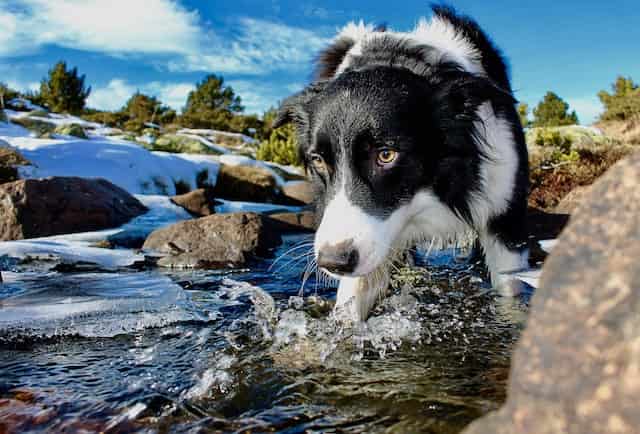
Why Do Dogs Have Whiskers: Uncovering the Science Behind Canine Facial Hair
Dogs have an array of features that contribute to their remarkable senses, one of which are their whiskers. Whiskers, also known as vibrissae, play an essential role in a dog’s ability to navigate and interpret their surroundings.
These tactile hair-like structures are not simply an aesthetic addition to your canine companion’s face; they provide crucial sensory feedback for the dog’s daily activities. In this article, we will explore the reasons behind the existence of whiskers in dogs and how they function to enhance their perception of the world around them.
It is important to understand that whiskers are not unique to dogs – many mammals, including cats, seals, and rodents, also have vibrissae. These intriguing structures can be found on various areas of a dog’s face, such as above the eyes, on the muzzle, and near the jaw. They serve multiple purposes, which we will delve into in the following paragraphs.
Anatomy of Whiskers
Whiskers, also known as vibrissae, are specialized hair-like structures found on the muzzle of dogs and other mammals. They are thicker and stiffer than regular hairs, with each whisker embedded deep in the skin within a follicle packed with nerve endings.
There are four main types of whiskers on a dog’s face:
- Mystacial whiskers: positioned on the upper lip, similar to a mustache.
- Genal whiskers: located on the cheeks.
- Supraorbital whiskers: found above the eyes.
- Interramal tufts: found below the chin.
Whiskers are arranged in rows, and their numbers and patterns can vary according to the breed, genetics, and individual differences in dogs. They are typically curved, allowing them to remain sensitive to touch from any direction.
The base of each whisker houses nerve endings that transmit sensory information to the brain, allowing dogs to gather valuable data about their environment, such as detecting air currents, changes in pressure, and nearby obstacles. This sensory function plays a crucial role in a dog’s spatial awareness and decision-making.
Functions of Whiskers
Dog whiskers, also known as vibrissae, serve various essential functions that aid in their daily activities and interactions. These specialized sensory hairs are much thicker and longer than regular fur, providing dogs with valuable information about their surroundings.
Some main functions of whiskers include:
- Navigation: Whiskers help dogs navigate their environment by detecting subtle changes in air currents, allowing them to avoid obstacles, even in low light conditions.
- Protection: The whiskers above the eyes act as a protective mechanism, reacting to nearby objects and triggering a blink reflex to shield the eyes from potential harm.
- Spatial awareness: The whiskers on a dog’s muzzle give them a better sense of the distance and location of objects, helping them avoid collisions and judge the size of openings or gaps.
- Social cues: Whiskers also play a role in communication, as they can convey emotions such as fear or aggression. The positioning of a dog’s whiskers can help other animals and humans understand their mood or intentions.
Overall, whiskers act as an essential sensory tool that enables dogs to better understand and adapt to their environment, enhancing their safety and social interactions.

Importance in Dog’s Daily Life
Whiskers, also known as vibrissae, play a crucial role in a dog’s daily life. They serve as sensory organs that provide the dog with valuable information about their environment, helping them navigate, investigate, and communicate with others.
Some of the essential functions of whiskers include:
- Navigating in the dark: Vibrissae can detect subtle changes in air currents, allowing dogs to sense nearby objects without touching them. This is particularly helpful when it is dark, enabling dogs to navigate with more confidence.
- Measuring aperture: By brushing their whiskers against the sides of an opening, dogs can determine whether they can fit through it. This helps to prevent them from getting stuck in tight spaces.
- Detecting prey: When a dog is following a scent, its whiskers work alongside its nose to detect vibrations caused by potential prey, increasing its chances of finding its target.
- Expressing emotions: Dogs use their whiskers to communicate their emotional state to other dogs and humans. For example, a dog may pull its whiskers back to appear friendly or push them forward to signal aggression.
Overall, whiskers are an essential part of a dog’s sensory system, contributing significantly to their ability to navigate, investigate and interact with their surroundings and other beings.
Caution When Grooming
When grooming your dog, it’s crucial to be mindful of their whiskers, as they play an essential role in their sensory abilities. Cutting or trimming a dog’s whiskers can cause them to become disoriented and stressed.
Here are some valuable tips for grooming your dog while preserving their whiskers:
- Always use tools designed specifically for pet grooming, such as brushes with soft bristles.
- When using scissors, trim your dog’s fur with caution, ensuring that you avoid cutting whiskers by accident.
- If your dog requires professional grooming, select a reputable groomer and inform them about the importance of your dog’s whiskers.
- Examine your dog’s whiskers during grooming sessions and clean them gently, taking care not to pull or tug.
By being attentive and gentle during the grooming process, you can maintain the health and function of your pet’s whiskers, ensuring that they can continue to navigate their environment safely and effectively.
Conclusion
In summary, dogs have whiskers to enhance their sensory abilities, allowing them to navigate their environments better and detect changes in their surroundings. Whiskers, also known as vibrissae, enable dogs to gather information about nearby objects, air movements, and even the emotions of their human handlers.
Understanding the importance of whiskers for your dog’s overall well-being and sensory abilities is crucial for dog owners. It is essential to refrain from trimming or removing a dog’s whiskers to prevent any negative impacts on their day-to-day lives.
Ultimately, whiskers are a fascinating and functional aspect of a dog’s anatomy, serving as valuable tools for communication, navigation, and socialization. Respecting and maintaining your dog’s whiskers can contribute to a happier and more confident furry companion.